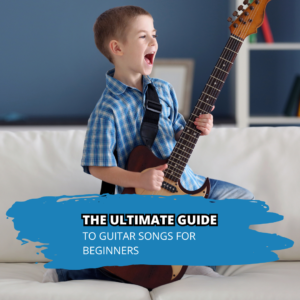The Ultimate Guide to Guitar Songs for Beginners

The Importance of Starting with Simple Guitar Songs
Starting your musical journey with guitar songs for beginners is not just about simplicity; it’s about building a solid foundation. Simple songs allow you to focus on the fundamentals of guitar playing, such as finger placement, strumming technique, and chord transitions, without feeling overwhelmed. They offer a sense of achievement that motivates you to keep practicing. Each chord you master and song you play adds to your confidence and skills, setting you up for more complex pieces in the future.
Understanding Your Guitar: Anatomy and Tuning
Before diving into guitar songs for beginners, it’s crucial to familiarize yourself with your instrument. Understanding the anatomy of your guitar, from the headstock to the bridge, helps you communicate about your instrument and troubleshoot common issues. Tuning your guitar is a foundational skill that ensures the chords you play sound correct. Regular tuning practice also develops your ear, an essential tool for any musician.
Mastering the Essential Chords
The path to becoming proficient at the guitar is paved with chords—those magical combinations of notes that give songs their emotion and depth.
Open Chords for Beginners
Open chords are the building blocks of countless guitar songs for beginners. These chords are played using a combination of strummed open strings and fretted notes. Mastering open chords like G, C, D, E, and A minor opens up a world of song possibilities. These chords are not just easy to learn; they’re also versatile, forming the backbone of many genres, from folk to rock.
Practice Techniques for Smooth Chord Transitions
Smooth chord transitions are essential for playing guitar songs for beginners fluidly. Start slow, focusing on the movement of each finger between chords. Use a metronome to gradually increase your speed without sacrificing accuracy. Practice transitioning between chords you find challenging, and incorporate muscle memory exercises to make these movements second nature.
Basic Strumming Patterns and Rhythms
Rhythm is the heartbeat of music, driving the pace and feel of songs across all genres. For the aspiring guitarist, mastering basic strumming patterns and rhythms is akin to learning the language of music.
Understanding Strumming Patterns
Strumming patterns dictate the rhythm and feel of guitar songs for beginners. They are combinations of downstrokes and upstrokes that you play on the strings. Learning basic patterns helps you maintain steady timing and adds dynamics to your playing. Start with simple downstroke patterns before incorporating upstrokes and mixed patterns to mimic the rhythm of your favorite songs.
Exercises to Improve Your Rhythm
Improving your rhythm is crucial for playing guitar songs for beginners effectively. Practice strumming with a metronome to develop a consistent tempo. Clap along to different rhythms to internalize them before applying them to your guitar playing. Playing along with recordings of simple songs can also help you understand how strumming patterns fit within a musical context.
Combining Chords and Strumming Patterns
The fusion of chords and strumming patterns marks a significant milestone in the journey of learning guitar. This combination is where music truly starts to take shape, turning basic elements into full-fledged songs.
Step-by-Step Guide to Playing Your First Song
Combining chords and strumming patterns is your first step towards playing complete guitar songs for beginners. Choose a simple song with chords you are comfortable with. Break the song down into manageable sections, and practice each part slowly. Focus on maintaining a steady rhythm as you transition between chords. With patience and practice, you’ll be able to play the song seamlessly.
Tips for Effective Practice Sessions
Effective practice sessions are key to mastering guitar songs for beginners. Set realistic goals for each session, focusing on specific chords, transitions, or parts of a song. Take regular breaks to avoid fatigue and frustration. Recording your practice can help you identify areas for improvement. Remember, consistency is more important than the length of your practice sessions.
Simple Guitar Songs for Beginners
Delving into simple guitar songs offers beginners the chance to apply their skills in a practical, enjoyable way.
Easy Songs to Start With
Starting with easy guitar songs for beginners can boost your learning curve and keep you motivated. Songs with simple chord progressions and strumming patterns allow you to focus on the fundamentals of playing. “Twinkle Twinkle Little Star” and “Horse with No Name” are great examples of songs that use minimal chords while still teaching you the basics of rhythm and melody. As you gain confidence, you can gradually tackle songs with more complex structures and faster chord transitions, further enhancing your skills.
Learning to Play Popular Guitar Songs for Beginners
Popular guitar songs for beginners often feature chords and patterns you’ve already practiced, making them excellent practice pieces. Songs like “Wonderwall” by Oasis and “Let It Be” by The Beatles use common open chords and simple strumming patterns, allowing you to apply what you’ve learned in a fun, enjoyable way. Learning these songs not only improves your playing technique but also expands your repertoire and understanding of different musical styles.
Advancing Your Guitar Skills
After mastering the basics, advancing your guitar skills opens up new avenues of musical exploration and expression.
Incorporating New Chords and Strumming Patterns
As you become more comfortable with the basics, it’s time to challenge yourself with new chords and strumming patterns. Adding minor chords, seventh chords, and barre chords to your repertoire increases the range of songs you can play. Experimenting with more complex strumming patterns, including those with syncopation and varied dynamics, will enhance your rhythm playing and make your performances more interesting.
Beyond the Basics: Next Steps in Your Guitar Journey
Advancing your guitar skills involves more than just learning new chords and songs. It’s about understanding the music theory behind what you play, improving your ear training, and experimenting with songwriting and improvisation. Joining a community of guitarists can provide valuable feedback and inspire you to continue growing as a musician. Remember, the journey of learning guitar is a continuous process of discovery and refinement.
Why Elite Music Academy?
Choosing Elite Music Academy as the starting point for your guitar learning journey means stepping into a world where passion for music meets educational excellence. Our commitment to nurturing musical talent extends beyond mere lessons; it’s about creating a supportive, enriching environment where beginners can flourish. Check out reviews from the community part of our academy!
Personalized Learning Paths for Every Beginner
We understand that every beginner has a unique learning style and musical taste. That’s why we offer personalized learning paths tailored to your goals and interests. Whether you’re looking to master guitar songs for beginners or aspire to become a professional musician, our experienced instructors are here to guide you every step of the way. With a focus on hands-on learning and real-world application, you’ll gain the skills and confidence to play with ease and expression.
The Community and Resources
Joining Elite Music Academy means becoming part of a vibrant community of musicians. We offer guitar lessons for all levels, including beginners, because we believe in nurturing musical talent from the ground up. Our approach combines technical proficiency with creative expression, ensuring that you not only learn how to play guitar songs for beginners but also develop a deep understanding and appreciation for music. With our dedicated instructors, supportive community, and comprehensive resources, Elite Music Academy is the ideal place to start your musical journey.
FAQs
1. How often should beginners practice guitar to see steady improvement?
Beginners are recommended to practice daily, even if it’s just for 15-30 minutes, to maintain consistency and steadily improve their skills.
2. Are there any specific muscle memory exercises for improving chord transitions?
Yes, practicing switching between chords slowly and deliberately without looking at the fretboard can help develop muscle memory, making transitions smoother.
3. What’s the next step after mastering basic chords and strumming patterns?
After the basics, beginners should explore more complex chords, like minor and seventh chords, and varied strumming patterns to enhance their playing style.
4. What are some common challenges beginners face when learning guitar, and how can they overcome them?
Common challenges include finger soreness, difficulty with chord transitions, and maintaining rhythm. Overcoming these challenges involves regular practice, starting slowly, and gradually increasing complexity.
5. Why is ear training important for guitar players, and how can beginners start developing this skill?
Ear training helps guitarists recognize chords, intervals, and melodies by ear, enhancing their ability to learn songs and improvise. Beginners can start with simple exercises, like trying to play melodies by ear or identifying basic chords.


